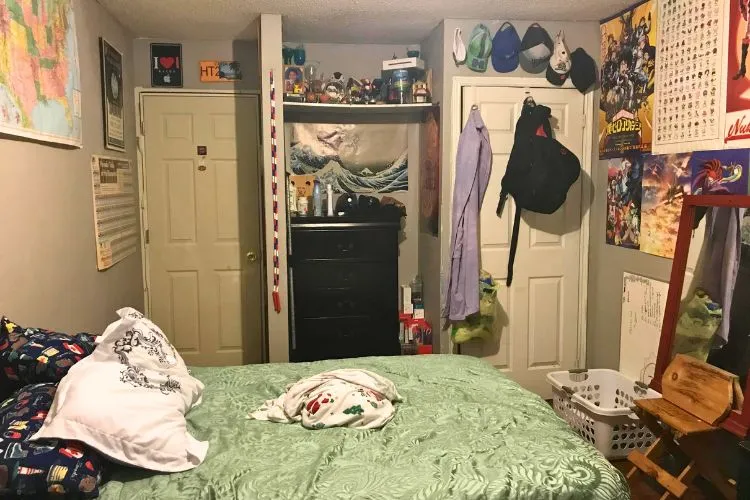Breathe easy in your own space. Fresh air matters. It promotes concentration, brings comfort, and impacts health. Imagine the adverse effects when air circulation is poor.
The result is a stuffy room. It’s uncomfortable, often accompanied by poor air quality and a heavy atmosphere.
Don’t worry. In this article I will guide you on how to fix a stuffy room in an easy to understand and affordable manner.
So you need to stay on this page for a bit more. But first we must understand the root cause of it.

What Causes a Room to Become Stuffy?
Rooms become stuffy from a lack of ventilation. Without fresh air, carbon dioxide and pollutants proliferate. Allergens such as dust mites and pet dander also contribute.
Stale air and odors remain trapped. The situation worsens in an overcrowded room. Excess furniture or clutter prevents air circulation. High humidity is another concern.
It creates a breeding ground for mold and mildew. Both are potential health hazards. The smell they produce further compounds the stuffiness.
What are the symptoms of a stuffy room?
A stuffy room is characterized by symptoms related to poor air quality and limited ventilation, causing various physical responses. Here are the common signs and symptoms associated with a stuffy room:

- Difficulty Breathing: When the circulation of fresh air is limited, you might have trouble breathing efficiently, leading to feelings of suffocation or lack of air.
- Allergy-like Symptoms: Stuffy rooms often lead to symptoms similar to those of hay fever, for instance, sneezing or a stuffy, drippy nose.
- Irritated Eyes and Sinuses: Insufficient ventilation and dry air can cause issues like irritated eyes and sinuses.
- Persistent Cough: A persisting dry or wet cough can also be a sign of a stuffy room.
- Headache and Fatigue: Lack of fresh oxygen can lead to headaches, lethargy, and fatigue.
- Aggravated Respiratory Conditions: If you have existing respiratory conditions such as asthma, these might exacerbate in a stuffy room.
Always ensure proper ventilation in your rooms to avoid such symptoms and to promote a healthy living environment.
How to Fix a Stuffy Room: A Detailed Guide
Stuffy rooms can become uncomfortable and even promote the growth of mold and mildew. Utilizing proper air circulation techniques, we can transform such spaces into more comfortable and breathable environments. Below is a step-by-step guide to help you fix a stuffy room.
Evaluate the Room’s Vents and Circulation
Inspect Vents
Take a look at your room vents. Make sure they are open and not obstructed by furniture or curtains. Blocked vents can restrict air flow causing a room to become stuffy. If they are closed, open them up and clear any blockages if possible.
Circulation Checkup
If your room has ceiling fans, ensure they are regularly cleaned and in good working order. The direction the fans rotate is also essential.
In the winter, they should rotate clockwise at a low speed to draw room air up towards the ceiling. During the summer, the blades should move counterclockwise to push cool air down to the floor.
Regular Cleaning
Stuffy rooms are sometimes the result of dust and dirt accumulation. Regular cleaning is vital.

Vacuuming
Vacuum the floors and any upholstered furniture regularly to remove dust, which can harbor dust mites and allergen particles, contributing to a stuffy feel.
Deep Clean Rugs
Deep clean carpets and rugs since they can hold lots of dust and allergens. If you have severe allergies or asthma, you may want to consider removing carpets and rugs altogether.
Use of Air Purifiers and Dehumidifiers
Air Purifiers
Air purifiers can help remove allergens like dust, pet dander, and mold spores from the air, which can help make a room feel less stuffy.
Dehumidifiers
If your room is stuffy due to excess humidity, a dehumidifier may prove beneficial. It helps in reducing indoor moisture levels, which can decrease the possibility of mold and mildew growth and eliminate any musty smells.
Increase Air Flow Using Doors and Windows

Open Windows
Open windows can drastically improve the ventilation of a room, which, in turn, aids in reducing stuffiness.
Use of Doors
If your room has more than one door, opening both can create a cross breeze that can significantly increase airflow.
Add Houseplants
Certain types of houseplants are excellent for improving a room’s atmosphere. They can help remove carbon dioxide and toxins while adding fresh new oxygen.
Specifically, plants like the Snake Plant, Peace Lily, and Pothos are known for their abilities to clean and freshen the air.
However, remember to not overwater your plants since that can increase the room’s humidity level.
By following these steps, you’ll be able to transform your stuffy room into a comfortable and healthier space quickly. Always remember, ventilation is the key to keeping any room from becoming too stuffy.
What happens if you sleep in a stuffy room?
Sleeping in a stuffy room can potentially have negative impacts on your health and sleep quality. Limited fresh air and increased levels of carbon dioxide can lead to difficulty in breathing, which acts as a sleep disruptor.
Extreme stuffiness may exacerbate certain respiratory conditions, like asthma, leading to uncomfortable or dangerous nighttime episodes.

Furthermore, high levels of dust and allergens often found in stuffy rooms can trigger allergy symptoms, such as runny nose, congestion, and itchy eyes, all of which can be disruptive to sleep.
Stuffy rooms are also often humid, promoting the growth of mold and mites, which can exacerbate allergies.
Finally, a lack of airflow can cause a room to feel uncomfortably warm, which can also impair sleep quality. Therefore, maintaining proper ventilation and indoor air quality is crucial for achieving a good night’s sleep.
Preventing a Room from Becoming Stuffy
Maintenance prevents stuffiness from recurring. Replace air filters regularly. They trap pollutants that contribute to stuffiness. Dust build-up impairs their function.
Furniture placement helps too. Arrange it to promote airflow. Keep pieces away from vents or radiators. Regular cleaning is also a must. It keeps allergens and pollutants in check.
Frequently Asked Question (FAQs)
Will a dehumidifier help a stuffy room?
Indeed, a dehumidifier can reduce excess moisture. It makes the room less hospitable to allergens. These include mildew, mold, and dust mites.
Why is my room so stuffy and hot?
A room could be stuffy and hot due to poor ventilation. It could also be due to high indoor humidity. Overcrowding also raises the temperature.
Will an air purifier help with a stuffy room?
Yes. Air purifiers remove pollutants and allergens. They improve indoor air quality.
How do I fix a stuffy room at night?
Ensure sufficient ventilation. Use fans or open a window. Regularly clean your room to reduce dust and allergens.
Conclusion:
Freedom from stuffy rooms is achievable. It all boils down to ventilation, humidity control, cleaning, and preventive measures. Implement these strategies.
Breathe in relief. Your room is now a haven, promoting comfort, health, and peace of mind. It’s time to enjoy your space as it should be – fresh, breezy, and inviting.


